Day: September 1, 2022

A Bridge From Transport Connectivity to Economic Corridor
The opening of the Padma Bridge has created the scope for a new wave of investment in the country’s south and south-western region. The region’s easier road communications with the rest of the country has brought fresh momentum for business growth. New industries are being planned and tourism sector entrepreneurs are hoping for a business boom surrounding Kuakata sea beach and the Sundarbans. Thus, the bridge has offered a new economic corridor in the making. Economists and business leaders believe with remarkable improvement in road network though the bridge trade and business in the region would expand rapidly, raising the people’s income, creating jobs and eradicating poverty. The Padma Bridge is also expected to bring about a massive change in the entire economy. The Ministry of Road Transport and Bridges believes the economic corridor surrounding the Padma Bridge and its adjacent areas would increase the country’s GDP (gross domestic product) growth by 1.27 percentage point. The southern region’s economy will grow at a higher pace. Predicting a higher GDP growth for the Padma Bridge, the Asian Development Bank (ADB) said the rate of poverty reduction will be accelerated by 0.84 per cent every year. However, as many as 53 upazilas out of 133 upazilas in 21 districts on the south-western side of the bridge are of high concentration of poverty, according to Bangladesh Bureau of Statistics (BBS) poverty map. Another 42 upazilas are in the medium poverty risk category and 38 in low poverty risk category. Economist and chairman of Palli Karma-Sahayak Foundation (PKSF) Quazi Kholiquzzaman Ahmad said small entrepreneurs are more enthusiastic about the Padma Bridge and they should be provided with opportunity to make investment and various supports such as gas and electricity supply should be ensured at affordable costs. He observed that the bridge has jointed the southern belt with the rest of the country. The bridge will result in smooth transportation of farm produces from the region, according to Implementation, Monitoring and Evaluation Division (IMED) of the Ministry of Planning. It said farmers’ income will increase 15-20 per cent since direct connections between farmers and the market forces will be established. Transport sector insiders added the time for transportation of goods from Benapole to Dhaka would come down to 6-7 hours from 24-36 hours. The southern region was attractive for low-cost transport of goods by river routes but longer time and uncertainity in ferry services earlier discouraged the entrepreneurs from taking business initiatives. The Padma Bridge has now created the scope for big companies to come forward with investment projects in the region. The companies that have shown interest in setting up factories in the region include Sheltech, Pran-RFL, TK Group, Envoy Group, Hameem Group, Mir Group, Karim Group and Opsonin Pharma. Bangladesh Economic Zones Authority (BEZA) has unveiled a master plan on Padma Bridge that would directly benefit Dhaka, Khulna and Barisal divisions. It is taking steps to establish 17 new Economic Zones (EZ) in 21 districts of the three divisions. In the 1960s, Khulna became one of the few industrial hubs of the country but it has subsequently lost the glory. However, after the launch of Padma Bridge, Khulna is drawing attention of the investors. Abdus Salam Murshedi MP, president of Bangladesh Exporters’ Association (BEA) and former president of BGMEA said, “I definitely want to use this opportunity. I want to set up a new garment factory in Khulna. I also encourage others to invest in the region.” In fact in 2019, Sheltech Group established the country’s largest ceramics industry in the southern district of Bhola. The company invested more than Tk 7 billion taking advantage of local natural gas and cheap land with the hope of opening of the Padma Bridge in 2022. Now, Sheltech is also planning to set up a non-denim garment factory in Bhola, said Engineer Kutubuddin Ahmed, chairman of the group. “We are now looking for land to set up a ready-made garment industry in Barisal. After the inauguration of the Padma Bridge, investing in the south is the most promising one,” he added. Chini Tikri The Inaugural Murals By 15,000 Ceramic Plates One of the two spectacular installations at each end of the Padma Bridge is its inaugural mural – which has been constructed by using 15,000 ceramic plates. The portraits of Father of the Nation Bangabandhu Sheikh Mujibur Rahman and Prime Minister Sheikh Hasina have been made by breaking these 37 coloured plates into ‘Chini Tikri’. One was the dreamer of Padma Bridge and the another one is its implementer. As the ceramic plate is broken and made, it starts to sparkle when the sun shines on it. These ceramic plates are hammered and broken into about half a million pieces. Then different colours of the pieces are arranged one after one to create two beautiful portraits. Designed by architect Fazle Karim Shishir of Drishik, the two murals were created by artists Ashraful Alam Riaz and Didar Ul Alam. Both are graduated from the Fine Arts Institute of Dhaka University. The 90-feet-long and 45-feet-high mural at the Mawa end was done by Didar Ul Alam and the 72-feet-long and 36-feet-high mural at the Janzeera end was done by Ashraful Alam Riaz. They told Ceramic Bangladesh that at first the designer thought of making this mural with ceramic tiles, but later they chose ceramic plates of the highest quality considering the bright colour and durability. A total of 15,000 plates of 37 types of colours have been used here. Among them, 7 types of coloured plates are used to display black and white portrait of Bangabandhu. And 30 types of coloured plates are used to produce colourful portrait of Prime Minister Sheikh Hasina. All of these ceramic plates are customised. Because such a variety of colour plates are not usually produced by ceramic companies. Artisan Ceramics made 8,000 plates used in the Mawa end mural and Monno Ceramics made 7,000 plates used in the Janzeera end mural. This construction work was completed in two months by two
Read More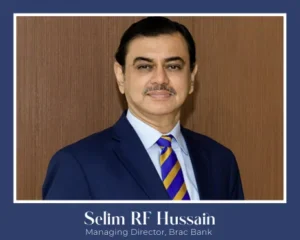
Ceramic industry has high potential to flourish: Selim RF Hussain
In an Interview with Ceramic Bangladesh, the Brac Bank MD & CEO says the growing industry can help fulfill Bangladesh’s sustainable development goals. Selim RF Hussain is a Bangladeshi career banker with over 35 years of diversified local and international banking experience. He is currently heading Brac Bank Limited, one of the country’s leading full service commercial banks, with an asset base of approximately US$ 5 billion, and one that is known for its particular focus on the SME segment. Mr. Selim joined Brac Bank in November 2015, and within a relatively short period, has led the bank to the top tier of the 60 odd scheduled banks in Bangladesh. He has been elected Chairman of the Association of Bankers, Bangladesh (ABB) for the period 2022-23. He is a member of the Governing Board of the SME Foundation, an apex semi-government institution spearheading SME development. He is a member of the Governing Board of the Financial Alliance for Women, an international network of financial institutions dedicated to championing the female economy. Mr. Selim is also on the Board of the Global Alliance for Banking on Values (GABV), an international network of banks that use finance to serve people and the planet. Mr. Selim also represents Brac Bank in multiple Brac Bank subsidiaries through board directorship – at Brac EPL Investments Ltd, Brac EPL Stock Brokerage Ltd, Brac Saajan Exchange Ltd and Brac IT Services Limited. He is the Chairman of the Board Audit Committee of bKash, Bangladesh’s largest mobile financial service company, and also the Vice-Chairman of the Industrial Infrastructure Development Finance Company (IIDFC), a non-banking financial institute. Ceramic Bangladesh (CB): Would you please tell us something about Brac Bank and its inception? Selim RF Hussain: Brac Bank started its journey in 2001 as a private commercial bank focussing on small and medium enterprises (SMEs). Our visionary founder – Sir Fazle Hasan Abed KCMG established the bank to facilitate easy access to formal f inancing for the grassroots SME entrepreneurs who are usually left out in the traditional banking system. The bank has pioneered small-ticket unsecured loans to bring the unbanked missing middle under the banking umbrella. Over the years, it has emerged as the country’s largest financier of collateral-free SME loans. With a dynamic network of 187 branches, 456 SME unit offices, 373 ATMs, and 800 Agent Banking outlets across the country, Brac Bank offers seamless banking services for Retail, SME, and Corporate segments serving 1.3 million customers. The majority shareholding of the bank belongs to Brac, the largest non-government organisation in the world. CB: What has actually enabled the bank to rise to the top? Selim Hussain: Brac Bank is a different bank altogether in the banking sector. It is the only bank in the country, with most shareholdings belonging to institutional investors. Its Board is comprised of independent directors who are expert professionals in their f ield. This organisational structure gives the bank a solid foundation to become a standard bearer in governance, transparency, ethics and compliance. Brac Bank’s superior performance indicators in the Bangladesh Banking Sector are reflected in the highest market capitalisation, the highest international investor shareholding in the local banking sector, and the highest bank credit.rating of all banks in the country from both international rating agencies, S&P and Moody’s. The bank leads the local banking industry in nearly all financial metrics and is a benchmark for corporate governance and values-based banking. CB: How is Brac Bank different from other banks? Selim Hussain: Brac Bank focusses on SME banking. It provides small-ticket and collateral-free loans to SME entrepreneurs, an attribute that sets the bank apart in Bangladeshi banking sector. The bank plays a vital role in bringing the unbanked missing middle under the banking system. With its SME Banking, Agent Banking and Women Banking propositions, Brac Bank contributes significantly to financial inclusion in the country. CB: What are the services you provide to your premium customers? Selim Hussain: We bring exclusive perks to our high-value customer segment. Premium Banking customers enjoy a host of benefits and privileges, including Dedicated Relationship Managers, Luxurious Lounges, One-Stop Service, Preferential Fees and Charges, Doorstep Service, Lifestyle Benefits, Exclusive Card Privileges, Customer Value Propositions, Priority at Call Centre Service. The customers are entitled to exclusive deals on shopping, dining, entertainment, healthcare, and special Infinite, Signature and Platinum credit card special offers. CB: What facilities are you providing to the local manufacturing industries? Selim Hussain: In its 21 years of operations, Brac Bank contributed significantly to industrialisation in Bangladesh. Our Corporate Banking provides Working Capital, Capital Machinery, Project Financing and Lease Financing, Cash Management and Transaction Banking for large and emerging corporate organisations. Under SME Banking, the bank extends Unsecured Loan, Secured Loan, Women Entrepreneur Loan, and Secured Convenience Loan, leading to small-scale industries’ growth. CB: How do you see yourself as a partner in the growth of Bangladesh’s ceramic industry? Selim Hussain: The ceramic industry has high growth potential. Apart from meeting domestic demand, our ceramic manufacturers also export and earn precious foreign currency. This potential has led to renowned corporates making big investments in this manufacturing sector. Brac Bank provides banking and financing support to large-scale ceramic industries and small-scale ventures with customised solutions. CB: Do you have plans for more investments and providing more facilities to the ceramic industry? Selim Hussain: Being an SME-focussed bank, Brac Bank patronises grassroots entrepreneurs. We have already financed many small-scale ceramic industries and witnessed remarkable success. For example, our finance to Clay Image has created many jobs, especially for women artisans. We know that the growing ceramic industry can help fulfill sustainable development goals of No Poverty, Decent Work and Economic Growth, Industry, Innovation and Infrastructure. So, we stand for this vibrant and potential sector, helping it to flourish further. CB: Where would Brac Bank be in 10 years down the line? Selim Hussain: With modern technology, the banking sector is changing fast. We reckon, in a decade’s time, banking infrastructure will see radical change. The country will go cashless.
Read More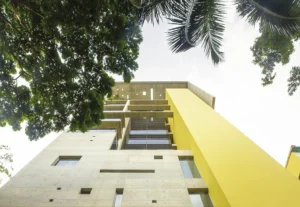
Sculpting Skyline: Unwilling contribution to the concrete jungle
Going down one of the most elite avenues of Dhaka city, the count of ones and twos will be less when it comes to the display of architecture by Mustapha Khalid Palash. Mr Palash, principal architect, and his team Vistaara Architects (Pvt.) Limited, have contributed to the new city skyline with significantly designed commercial buildings that are money-making machines for the economy. While passing by, young architects admire those works – this is quite an accomplishment for an architect, right? However, architect Mustapha Khalid Palash does not have a similar feeling. He is dissatisfied with the replacement of Dhaka’s natural landscape with man-made infrastructure, himself being a part of the contribution to the concrete ‘slum’ with added aesthetics. The nostalgic mind of this multi-talented person wanders around the city he was born in. He misses the vista of green and the landscape of Dhaka. All that visual relief has been lost in the name of fast-paced city development. The young Palash, born in the early 1960s on Baily Road, Dhaka, and later shifted to Gulshan in the mid-1990s, has a vivid scenario of life then: the environment, the lush and green of the city, and its cooling effect on the temperature in the good old days. The boom in population with unresolved planning about migration for a better lifestyle in the city is one of the main reasons for the overloaded condition in terms of size and expansion. Yet the lack of road networks and the commute system does not help much with stretching the city further north and south. Mr Palash believes decentralisation can be a solution to making these struggles better. The idea of scaling down architecture while maintaining its grandness is an old practice in this city. From the Mughal period to modern works by Louis I. Kahn and Muzharul Islam, but later it was lost somewhere in the city lines. A breathing space for the building and a gazing distance for the people are needed to observe large-scale architecture. Examples in Dhaka, as such, are the Mughal forts and palaces, the Sangshad Bhaban (parliament house), and a few others. As lifestyle developed, affordability increased. An unorganised building development started as people wanted to buy apartments over land due to a hike in prices. Hence in the last 20 years, the city became a concrete jungle from a greener jungle. Architect Palash brought back this practice in his design again. One can subconsciously understand the difference between standing in front of the Bashundhara Shopping Complex in the Panthapath area of the city, and Rangs Babylonia in Bir Uttam Mir Shawkat Sarak, on the Tejgaon-Gulshan link road. The inviting space in front of these buildings, on the street level, is the visual relief one needs while perceiving. Commercial building owners are keener towards using their well-known reputation in terms of selling spaces, and with reputation comes along building functionality and safety measures. “The architecture we design is not only for visual aesthetics that happens by default. We focus on delivery and timeline because a building is not just a space, it has a significant relation to the economy. Architecture is not just art. The basic system involves proper functional planning and the utmost safety measures for fire and structural factors. To me, architecture is like a tailored ‘coat’, where the inner lining of clothes has to be the most comfortable for the user, and the outer material has to be visually pleasing to the observer. The outer sight can differ from tastes, but the internal functionality has to be accurate,” explained Mr Palash. Architecture is a partial contributor to the destruction of this city, glorifying architecture is a cliché. He does not just design commercial buildings, but apartment buildings as well. His most well-known architecture though being on the prefaces of avenues like Gulshan is mentioned often. In all these years, he never designed a single-unit family residence, deliberately. He has done notable work in Chattogram and is currently working on a mass development project in Rajshahi. “The neo-modernism that our culture and society have gotten into has changed the social morphology to a different extent. The presence of a mobile phone is a distraction in relationships that has a social impact and even a lifestyle impact. Nowadays, apartment projects have ‘his and hers’ separate rooms, and the family living space culture is almost abandoned,” added the architect. Gulshan is already a heat island because of the excessive use of concrete, air conditioning and generator systems to support them. In addition to that the buildings are east or west facing on the avenue. Mr Palash and his team designed screening to reduce the internal effect of temperature. A few buildings even use photovoltaic glasses on the façade to produce renewable energy. “I have a hidden geometry while designing my buildings. I believe in signature, a handwritten signature, not rubber stamping.” “I have a hidden geometry while designing my buildings. I believe in signature, a handwritten signature, not rubber stamping. When I follow my geometric style, the buildings look like they are from the same house, but they are different in variation with visual expression” he mentioned. “The areas like Gulshan, Banani, Baridhara, Bashundhara R/A, Dhanmondi, and Uttara cannot be an example. The population density is much less there, and the distribution of basic commodities is also sufficient. The rest of the areas which are more organic, unsupervised, and ‘unorganised-ly’ growing are more in threat and should be taken care of” he added. Born to an artist couple, Mr Palash had exposure to art and culture since childhood. His confidence was developed in a very nurturing way by his parents, which eventually made his path of journey easy. “When I was 6, I used to assist my father with his commissioned works. If he had any works with letters, he used to draw the outline and ask me to fill it up in
Read More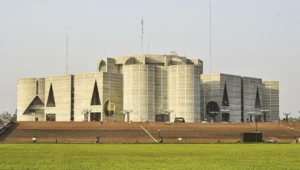
How National Budget can contribute to Ceramic Sector Growth
The current fiscal year’s national budget, passed by parliament on June 30, eyes taming inflation amid other major challenges to an economic rebound from the Covid-19 pandemic and recovery from impacts of Russia-Ukraine war. The annual outlay has finally stood at Tk 6,78,064 crore, 15.2 per cent of the gross domestic product (GDP) and of it, Tk 4,31,998 crore has been allocated for management cost and other non-development expenses and Tk 2,46,066 crore for annual development programme (ADP), which is also called development budget. The size of the budget for the fiscal year 2021-22 was Tk 6,03,081 crore. In the revised budget, it was brought down to Tk 5,93,500 crore. The revenue income in the new budget has been projected to be Tk 4,33,000 crore. The target of the National Board of Revenue (NBR) has been set at Tk 3,70,000 crore, non-NBR tax at Tk 18,000 crore, and non-tax revenue at Tk 45,000 crore. Foreign grant receipt is projected at Tk 3,271 crore. The budget deficit is Tk 2,45,064 crore (without foreign grant) which is 5.5 percent of GDP. To meet the deficit, Tk 2,41,793 crore will come from local and foreign loans, Tk 1,06,334 crore will be borrowed from local banks and the target of foreign loan is Tk 95,458 crore. Tk 40,000 crore will come from non-bank sources. Also, a projected amount of Tk 35,000 crore will come from savings certificates. An amount of Tk 17,000 crore will be spent on foreign loan repayment. The GDP growth target has been set at 7.5 per cent and inflation projected at 5.6 per cent. The finance minister acknowledged inflation as a concern. The government is committed towards controlling inflation by preventing inconsistencies between supply and demand. However, inflation has risen recently due to external and some internal factors. The finance minister, in his budget speech, said the global causes of inflation include rising inflation among trade partners, rising fuel prices, depreciating currency, disruption of the global supply chain, and the Russia-Ukraine war. But no visible adequate measures have been taken in the budget to control inflation. Deficit budgets are driving inflation. “Certainly, we shall be able to transform Bangladesh into a hunger and poverty-free society by achieving SDG (Sustainable Development Goals) in 2030, a higher-middle income country by 2031, a knowledge-based, happy and prosperous developed country by 2041 and a secured delta by 2100,” said Mustafa Kamal in budget session of parliament. Middle class brought under tax net The finance minister said the country’s middle or upper-class population is about 40 million, most of whom are not paying income tax. Efforts are being made to bring taxable people under the tax net by taking necessary steps to prevent tax evasion. As against a total TIN (taxpayers’ identification number) holder of 7 million, only three million are income taxpayers. The number of TIN holders will be raised to 10 million this year. Return submission will be made compulsory with some exceptions. The income tax exemption limit is Tk 0.3 million a year. “Certainly, we shall be able to transform Bangladesh into a hunger and poverty-free society by achieving SDGs in 2030, a higher-middle income country by 2031, a knowledge-based, happy and prosperous developed country by 2041 and a secured delta by 2100.” Huge trade deficit According to statistics from Bangladesh Bank, the nation’s trade deficit in goods was US$33 billion for the last fiscal year 2021-22 when the merchandise trade deficit was $33.25 billion. The current account deficit crossed $18.5 billion compared to $23.78 billion in the year before (FY21). Amid a huge balance of payments deficit, economists emphasised limiting imports and raising remittances. Recent central bank data show a significant increase in imports has made the trade gap bigger, putting pressure on the foreign exchange reserve and exchange rates. Based on the “free on board” (fob) price, the value of goods imported in FY22 was $82.49 billion, as against only $60.68 billion in FY21. Consequently, imports grew by almost 36% in FY22. Income from exporting goods (on a free-on-board basis) grew by 33.45% and reached $49.24 billion in FY22. In FY21, the sum was $36.90 billion. The overall balance deficit totaled $5.38 billion by the end of FY22 whereas there was a surplus of $9.27 billion in FY2020-21. The country received $21.03 billion in remittances in FY22, showing a 15.12 per cent decline over the previous fiscal. The central bank sold more than $1 billion to banks in July when the country received $2.09 billion in remittances, which was 11.76% higher than the amount received in July last year. Bangladesh’s foreign exchange reserves fell below $40 billion for the first time in two years recently. This was due to higher import costs and a weaker Taka against US dollars. The situation occurred due to the dollar’s rise over the past few months, when the central bank took some steps to discourage imports. Bangladesh Bank also encouraged Bangladeshis living and working abroad to send remittances. Ceramic sector needs budgetary support Mr. Mohammad Shirajul Islam Mollah, President of Bangladesh Ceramic Manufacturers and Exporters Association (BCMEA), in his budget reaction, demanded complete withdrawal of 15% and 10% supplementary duties imposed on domestic tiles and sanitary products respectively. He said if this is done, the price will decrease in the domestic market and the level of its use will increase. As a result, the government revenue will not decrease, rather increase overall. Commenting that ceramic tiles and sanitary products are no longer a luxury item, he said, they are considered essential construction materials. These are popular as eco-friendly products as they are helpful in creating a healthy environment. Ceramic is playing a helpful role in implementing the government’s ‘Sanitation for All’ programme. He said the ceramic sector is a labour-intensive industry with great potential. Machinery, technology and raw materials are not available in the country, so they have to compete with rich countries in procuring raw materials and technology as well as selling products. If a partial bond facility is provided along with
Read More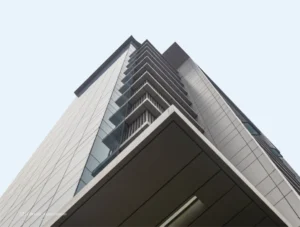
Business ethics & integrity are key to growing a company: Tanvir Ahmed
Mr. Tanvir Ahmed is the Managing Director of Sheltech Group. He is also the Director of Envoy Group, which includes textiles and garments and the first denim mill in the world to obtain a LEED Platinum certification. Envoy Textiles has recently been awarded the National Export Trophy (Gold). In the year 2014, Mr. Tanvir Ahmed was recognised, by the government of Bangladesh, as the youngest CIP at the age of 29 for his contribution to the national economy. He holds a Master’s degree from Cardiff University, the UK, and a Bachelor of Arts degree (with Honours) from Kingston University, the UK. He also obtained a Diploma from the London School of Economics (LSE). His area of expertise is business management, administration and finance and his entrepreneurship involve real estate, textiles and garments, hospitality service, financial trading, aviation and ceramics. He is currently an Executive Committee member of Bangladesh Employers’ Federation. He is also a Director at the India-Bangladesh Chamber of Commerce and Industry (IBCCI). He shared his present business ventures and future plans during an exclusive interview with Ceramic Bangladesh recently. Sheltech is a trusted name in the country’s real estate sector since 1988. The company has delivered more than 3,800 apartments in about 200 projects in various locations in Dhaka city. For quality management, it has obtained “ISO 9001:2015” as the first Bangladeshi real estate company. Sheltech follows the Bangladesh National Building Code (BNBC) and its projects are playing a vital role in consistent growth overcoming barriers. Designs are prepared following BNBC and all its projects are duly approved. It ensures international safety and quality standards in construction. The company maintains on-time handover of projects and after-sales care. No legal disputes can be found in its projects and that help a hassle-free registration. It believes in continuous innovation and improvement in products and services. “In most of the cases it is a lifetime investment for the clients. So, clients search for a company that is dependable. Timely delivery of real estate projects within budget and to the level of the quality standards specified by the client is an index of successful project delivery for real estate developers. Sheltech understands the scenario and work with full enthusiasm to ensure the clients’ needs,” said Mr. Tanvir Ahmed. However, it is a difficult process for the developer, as many critical issues need to be addressed to complete the project on time, which can only be accomplished by a well-structured and efficiently managed company, he added. On the overall real estate development in Bangladesh and the future of this industry, Mr. Tanvir said, “While the RMG sector and a few more industries are keeping this country’s economy afloat, there is one industry that has continued to grow surprisingly well – The Real Estate. It is one of the fastest-growing sectors in the country.” “Sheltech understands the scenario and work with full enthusiasm to ensure the clients’ needs. It has obtained ‘ISO 9001:2015’ as the first Bangladeshi real estate company” “The sector has seen tremendous growth in recent years, with the establishment of a number of new real estate companies and development of new projects. The present demand and trend for housing in the country allows us to think the future growth of this industry is very promising,” he said. The birth and making of Sheltech were led by Mr. Tanvir Ahmed’s f irst generation. He is the one from the second generation who is now following his ancestor’s footprint. Mr. Tanvir Ahmed started serving the hospitality industry through “Platinum Hotels by Sheltech” in 2008. He got involved with the real estate industry since 2010. Sheltech is always concern to reduce environmental impact of construction. It has set a standard for an environment-friendly construction process. Design of structural elements concerning critical combinations of gravity, seismic and other loads is thoroughly checked. “We maintain strict supervision by site engineers and the quality control team to ensure construction is according to design. We ensure shore protection during foundation. We provide a safe and organised construction environment through safe pedestrian movement, a soundless, dust and garbage-free construction site while ensuring labour safety,” said Mr Tanvir. From land acquisition to after-sales service, Sheltech provides one-stop solutions through architectural and structural design, construction management, interior solution, registration process, resolving legal issues, arrangement of utility connections, customer service after delivery and secondary market dealing through buying, selling and renting. Unlike other industries, the real estate industry has to overcome various challenges. It is a key engine of economic growth since it has a large multiplier effect on other sectors as well. It creates opportunities for its linkage businesses. Focusing on the growth, Mr. Tanvir said, “The real estate industry plays an increasingly significant role in the national economy, accounting for approximately 8% of GDP on average, and along with its 269 associated linkage industries, contributing about 12-14% to GDP. The worldwide lockdown imposed to control the spread of Covid-19 led to a global financial crisis. Bangladesh has also been affected economically. However, the pandemic effects are getting reduced and almost all business sectors are making a rebound.” “Despite the pandemic challenges, the real estate market recovered quite well in 2021. One of the main challenges for real estate developers is the increase in prices of construction materials. Apartment registration cost in Bangladesh is also quite high which becomes a burden for buyers and makes it more difficult to purchase apartments. Besides the home loan process and interest rate are an issue of concern for the sector,” Mr. Tanvir added. The trend and character of real estate development are very significant and this is a positive sign for development of the country. Nowadays housing supply largely depends on private developers. There are some limitations to operate a real estate business in Bangladesh. Sheltech always ensures development of a culture that provides simplicity in work and nurtures growth among the employees. Regarding the company’s culture and collaboration with others, Mr. Tanvir said, “We have an open-door policy among employees and their
Read More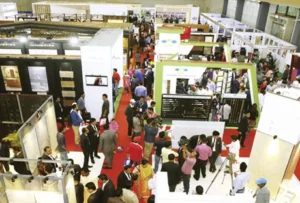
A Snapshot of International Ceramic Expos Worldwide
International Ceramic exhibitions are held worldwide for their distinctive ability to bring industrialists and technologists from different corners of the world into single platforms to serve the common purpose of promoting trade. The world’s most advanced technological innovations, equipment, raw materials, dynamic use of advanced ceramics and the best practices available are showcased in these international ceramic exhibitions. These exhibitions often additionally host B2B (business-to-business) meetings, seminars and conferences which result in strengthening professional networks and create further opportunities in establishing footholds in different parts of the world. Tecna – The Future of Surfaces, is an international marketplace organized at the heart of one of the most creative, innovative and technologically sound countries for surfaces, Italy. The exhibition offers the best innovations in aesthetics and processes for the sector every two years. Tecna, the international exhibition of technologies and surface supplies, is scheduled to be held at the Rimini Expo Centre, Italy, on September 27 to 30, 2022. The event is organized by IEG (Italian Exhibition Group) in collaboration with ACIMAC (Association of Italian Manufacturers of Machinery and Equipment for Ceramics). Today, numerous ceramic exhibitions are held around the world, which help display the latest materials and technologies and provide face-to-face networking and business opportunities to discuss the future challenges and opportunities facing the global ceramics industry. Tecna – The Future of Surfaces, is an international marketplace organized at the heart of one of the most creative, innovative and technologically sound countries for surfaces, Italy. The exhibition offers the best innovations in aesthetics and processes for the sector every two years. Tecna, the international exhibition of technologies and surface supplies, is scheduled to be held at the Rimini Expo Centre, Italy, on September 27 to 30, 2022. The event is organized by IEG (Italian Exhibition Group) in collaboration with ACIMAC (Association of Italian Manufacturers of Machinery and Equipment for Ceramics). Tecna represents a global meeting point for technology and innovation for the production of all types of surfaces and materials, from the most traditional to the most innovative ones. The exhibitors get the opportunity to meet national and international buyers from all sectors in the surface industry. Most participants are from Asia, Middle East, Africa, the Mediterranean Area, Europe and Latin America. CERSAIE – International Exhibition of Ceramic Tile and Bathroom Furnishings, is the foremost international event for designers of ceramic and other surface coverings and bathroom furnishings. The exhibition is due to be held at Bologna Exhibition Centre, Bologna, Italy, from September 26 to 30, 2022. The expo becomes a dynamic hub for architects or designers, retailers, contractors, installers, interior designers and even people looking to renovate homes or offices. One will get the chance to discover design ideas, architecture conferences, training events and meetings with production companies and discover the new offerings proposed by the market. The Foshan Tanzhou Ceramics Exhibition is due to be held from November 16 to 20, 2022 at Foshan Tanzhou International Convention and Exhibition Centre. The exhibition is organized by Foshan Taolian Technology Development Co. Ltd. The 5-day event will host over 400 exhibitors who will showcase the latest products, processes, and application designs. 20 heavy events will focus on the frontier hot topics of the industry. ASEAN Ceramics is Southeast Asia’s leading international exhibition of machinery, technology, raw materials and advanced ceramics. The event takes place in Thailand and Vietnam on alternate years and is organised by MMI Asia Pte Ltd, a full subsidiary of Messe Munchen GMBH (MMG). ASEAN Ceramics 2022 will take place in Thailand at IMPACT Exhibition and Convention Centre, Bangkok from November 30 to December 02, 2022. The exhibition will also host a three-day conference that would include a high-level plenary sessions and feature a series of presentations and panel discussions on topics ranging from new research on global innovations trends to their impacts on the global ceramic industry by globally renowned speakers. ASEAN Ceramics attracts over 4,000 trade visitors from close to 50 countries. The top visiting countries include China, India, Vietnam, Malaysia, Japan and Indonesia. The Highly Functional Material Week is organized by RX Japan Ltd. and has two shows, one held in Tokyo and the other in Osaka. The Tokyo show will be held from December 7 to 9, 2022 at Makuhari Messe and the show in Osaka will be held from May 17 to 19, 2023 at INTEX Osaka, Japan. The material week focuses on a range of matters, from film technology, metal, plastic, adhesion and bonding, paint and coating and also highly functional ceramics. The show will feature innovative structural materials, sustainable materials, materials for antibacterial and antiviral and materials for next-generation battery manufacturing. Indian Ceramic Asia, the 17th Edition of the state-of-the-art annual trade fair, is scheduled to be held at the Helipad Exhibition Centre, Gandhi Nagar, India, from February 15 to 17, 2023. The trade fair is jointly organized by Messe Munchen India, a subsidiary of Messe München GmbH and Unifair Exhibition Service Co., Ltd. The Indian ceramic industry has the potential to become one of the largest producers of ceramics in the world and is looking to double its turnover by 2024. This trade fair and conference for the ceramic and brick industry offers a curated platform for all leading companies to showcase their latest machinery, high-quality raw materials, analysis and laboratory equipment, storage equipment, material handling and much more. This presents the manufacturers or suppliers of raw materials or ceramic production equipment with a platform to meet new partners and clients and help their businesses grow in India. The 8th Edition of Ceramics Expo 2023, co-located with Thermal Management Expo is to be held at Suburban Collection Showplace, Novi, Michigan, USA, from May 1 to 3, 2023. The Ceramics Expo brings together engineers, decision-makers, end-user OEMs and buyers from across the globe to source new materials, components and technologies, network with like-minded professionals, and discuss the challenges and opportunities in the technical ceramics industry. The expo will also host a conference where industry leaders will share their
Read More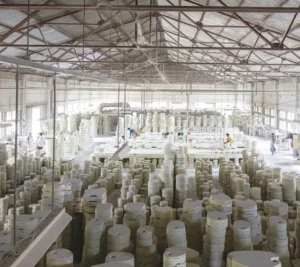
Shinepukur Ceramics Export Giant In Tableware Market
Becoming the number one is a challenge, and retaining that position brings about a bundle of never-ending hurdles that very few companies can tackle. Shinepukur Ceramics Limited (SCL) has been in the top position in the tableware segment, in terms of revenue and market share, for the past couple of years. Export is Shinepukur’s strong suit – It has been exporting high-grade porcelain (since April 1999) and bone china (since November, 1999) tableware and has established dominance in the export market. The company’s CEO says quality is the core reason why SCL products are in such demand abroad. It exports products the USA, Canada, the UK, Germany, France, Italy, Japan, Sweden, Norway, Denmark, Finland, Spain, Poland, Mexico, Brazil, Chile, UAE, Australia, New Zealand, Turkey, India, Egypt and Russia. Shinepukur’s “compliant factory” has been audited multiple times by SMETA, BSCI, GMP, and CTPAT, and has received an ISO 9001:2015 certification. Its tableware complies with the Norwegian Standard, California State Prop 65 Standard, and the EU Standard. Dhaka) shelters the SCL, a member company of Beximco Group. Registered in 1997, the company’s plants were commissioned in 1998, and started production in 1999. BEXIMCO Industrial Park (near Dhaka Export Processing Zone, 40 kilometres off Shinepukur is capable of making surreal tabletops with high durability for airlines, hotel ware, and other industrial usage. The versatility of the production houses allows the company to reach out to all demographics of ceramic users all over the world. The glaze is free from lead and cadmium free and of course health hazards, and its designs are demandingly likeable.ecoming the number one is a challenge, and retaining that position brings about a bundle of never-ending hurdles that very few companies can tackle. Shinepukur Ceramics Limited (SCL) has been in the top position in the tableware segment, in terms of revenue and market share, for the past couple of years. Export is Shinepukur’s strong suit – It has been exporting high-grade porcelain (since April 1999) and bone china (since November, 1999) tableware and has established dominance in the export market. The company’s CEO says quality is the core reason why SCL products are in such demand abroad. It exports products the USA, Canada, the UK, Germany, France, Italy, Japan, Sweden, Norway, Denmark, Finland, Spain, Poland, Mexico, Brazil, Chile, UAE, Australia, New Zealand, Turkey, India, Egypt and Russia. Shinepukur’s “compliant factory” has been audited multiple times by SMETA, BSCI, GMP, and CTPAT, and has received an ISO 9001:2015 certification. Its tableware complies with the Norwegian Standard, California State Prop 65 Standard, and the EU Standard. Dhaka) shelters the SCL, a member company of Beximco Group. Registered in 1997, the company’s plants were commissioned in 1998, and started production in 1999. BEXIMCO Industrial Park (near Dhaka Export Processing Zone, 40 kilometres off Shinepukur is capable of making surreal tabletops with high durability for airlines, hotel ware, and other industrial usage. The versatility of the production houses allows the company to reach out to all demographics of ceramic users all over the world. The glaze is free from lead and cadmium free and of course health hazards, and its designs are demandingly likeable. Technology Shinepukur uses machineries procured from Japan’s TAKASAGO, MINO, and SKK. It uses latest technology to produce world class products. For the Bone China Unit, the company uses technology transferred by NIKKO Japan. SCL has over 3,000 skilled workers and the company provides extensive training to all the workers. When it comes to quality control and product testing, SCL has its own laboratories, raw material disposal set up, gas-based power generation plant, water supply from deep tube-well, and sanitary facilities. For safety, it has kept in house doctors for the medical centre. The machineries for porcelain and bone china tableware are sourced from Germany and also Japan. These machines are capable of producing 4.5 million pieces of Bone China and 10 million pieces of Porcelain Tableware annually. Interview with CEO Mr. Humayun Kabir “Companies rise and fall based on how well they can predict and prepare for the future and finally, how accurately they execute their preplanning. Ceramic giants are constantly f ighting never-ending challenges and Shinepukur as a ceramic frontrunner has faced the worst of them. Shinepukur’s current dominance in the market is due to the lion’s share it holds when it comes to export,” the Chief Executive Officer (CEO) of Shinepukur Mr. Mohammed Humayun Kabir FCA told Ceramic Bangladesh. About the growth of the company, he said. “We won the export trophy nine times; of them five are Gold trophies won in five consecutive years from FY 2014-15 to FY 2018-19 while the first gold trophy was won in FY 2000-01.” “We don’t necessarily work to win awards and trophies. Rather, the awards come later in recognition that inspires us for the future,” added Mr. Kabir. One of the driving forces is meeting the stakeholders’ interests. “The company must have sustainability. We have a drive for sustainable growth and that has been the key to winning national export gold trophies so many times,” he pointed out. “Supplying sources of ceramic tablewares shift from one country to another” Mr. Kabir stated that the company management wants all the stakeholders to get their due share from the company. “Since Shinepukur is a listed company and has large number of shareholders, the company practices code of Corporate Governance in true spirit. The board is separate from the management. The board members are representatives of the shareholders and are responsible for framing policies. The management is comprised of professional managers and is responsible for planning and operations of the company within the policies framed by the Board. The management focusses on the return on investment, because, the shareholders who have invested in the company are expecting better return.” Mr. Kabir explained. “In this regard our journey was neither easy nor smooth. Shinepukur has to face the competition, tackle counterforce and survive,” he added. Tackling counter-forces The pandemic period was a struggle for many; it was a prolonged counterforce. During April-June
Read More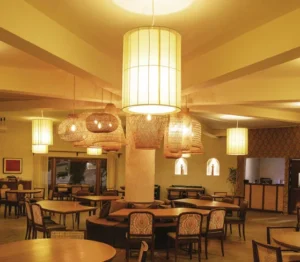
Tradition Wrapped In Modernity: Terracotta Tales
In the fast-moving pace of Dhaka city, do we not all feel the need to slow down, away from the chaos, experience the presence of the surroundings, and stay in the moment? Inside the premises of the Tejgaon branch of Aarong, Terracotta Tales pays homage to the local craftsmanship. It is a place dedicated to the warm and sentimental dishes and the comforting and heartfelt ambiance that make us long for home. Rafia Mariam Ahmed, principal architect of Hive Architects, designed this beautiful restaurant having intimate dialects with details. When an individual experiences space, what does make one recall it? What works there is the phrase: “design is in the details.” The goal of embracing details is to get you to think critically and present the best possible solution —right from the beginning. That is why details are important. They can keep us coming back, or they can keep us from coming back. And definitely, that comes from a good number of researches. Terracotta Tales is one such location where traditional village home details are infused into a minimal modern portrayal. Terracotta Tales and the adjacent bakery, Dough Diaries, are in a joint venture with Aarong. They are one of the restaurants under the Emerald Restaurants, with other operational restaurants being: Thai Emerald, The Red Chamber, Grove, Trouvaille, Gusto, and Emerald Bakery. The structure the restaurant belongs to was initially designed by Vitti Sthapati Brindo Ltd. alongside the Aarong outlet. The outlook of the structure, starting from the large openings, landscape, and interior to the detailed texture on the outer surface – all were later added as the journey of designing this tale began. The theme and menu of the tale were to be Bengali cuisine, from where conceptualisation of the space began. “I started going back to our roots of being a Bengali. I wanted to pick the elements so rich with history, which had been used daily in our culture, for so many years, and blend these elements with modernity. I wanted to design a space that would take us back to where we belong, a place more oriented towards slow living,” Ms Rafia shared. The space is an abstract representation of a mud house, the softness of which is found in the details of rounded corners of walls, doors, and windows. The unevenly matte polished surfaces with raw, warm earthy colours take you to the affection of the rural aura. Even at night, the lighting is as such to create the ambiance of a warm-toned hue of “prodeep” (dimmed fire lamp). The centre light pieces are delicately handwoven cane shades. Terracotta has been used in many details of this space. In the shade of the walkway, with that of the semi-outdoor space on the rooftop, and the centre of attraction is the wall of the stairway that leads to the rooftop dining. The wall is composed of thin slates of terracotta tiles arranged in triangular patterns, which creates dialects with the light from the sky at different hours of the day. The lanterns used in the rooftop space are also custom-made of burnt clay. As clay is a vital component of humans, country, and roots, the concept and name were associated with terracotta to represent its power of affection. Tales of local artists and craftsmen were incorporated into the design by the use of cane lanterns and clay lamp shades and the famous “Tepa Putul” (a local handmade clay doll of a specific style). Potters and artists made larger sizes of these usual small-scale dolls that are placed on niches as commonly seen in the mud houses. Framed rustic metal jewelry and decorative mirror are added to the wall to represent the daily used materials in a rural mud house. The landscape is designed to wrap an individual with nature. The restaurant is pedestrian-only, with no vehicular connectivity directly, focusing on the practice of being close to nature. The walkway has a beautiful line of bamboo trees on one side and specifically selected floral trees on the other. There is also an outdoor sitting area where the hard surface meets the green in an undulating line. A small body of water curves along the structure is an abstract form of “pukur” (a pond) as commonly seen in the rural context. Ms Rafia said, “The mere attempt was to get out of the edged effect of modern city life to a more mellow and soulful experience – Where one can only indulge in the presence of themselves, the company, and, of course, the food. The trees shed flowers and leaves, creating an inviting bed of nature for the people exploring the outdoors. The curved walkways toward Dough Dairies also give you a feel of the rural memories.” The subconscious nostalgia with the cane-woven furniture details makes one reminisce childhood memories from the ancestral homes. The utility area has been partitioned with cane-weaved partitions to camouflage it in the interior. The wooden curtain rails and the door handles add value to the theme, complementing the colour palette. A few subtle colours are added by using a floral print material on the back of the seats, preventing the guests from feeling monotonous. Old ceramic plates are decorated on the wall, making a spectacular composition of colours, history, and belongingness. On a bright sunny afternoon, when the sun kisses the shallow water next to the large window with curtains of translucent softness, the sheening glitter of the rippling water reflecting on the ceiling catches one’s attention while being indulged in the nostalgic local cuisine. The soul runs through the handcrafted details and the softness of the ambiance makes one feel warm, cozy, and at home. The modern city crowd is so much more over-oriented towards a captivated lifestyle that even a natural splash of water becomes a form of irritation. Terracotta Tales is a space to celebrate that naturally unnatural necessity of life that people are slowly getting carried away from. Authored by Rehnuma Tasnim Sheefa
Read More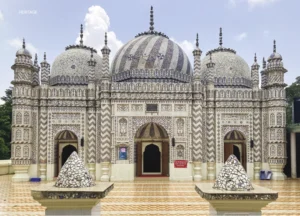
The Voyage of Bajra and Rangeela’s Mosque
Rangeela is the word which denotes vibrant/joyous, often mixed with quirkiness. So is the tale of Bajra Shahi Masjid, apparently unconnected unless it is told. After all, how many 281 years’ old mosques do you know named after a watercraft! Being a silent witness like a vessel through the waves of time, while breathing over four separate centuries, this Chinni-tikri skinned sublime architecture was built in the middle of a village. It has such a riveting history that it is a bit arduous to decide where one should begin while trying to tell its tales. With Rangeela, shall we, to unravel the ‘mystery’? Abu Al-Fatah Nasir Ud-Din Muhammad Shah was another one-of-a-kind emperor in the collection of Mughal Empire emperors. Passing away at the age of 45 this interesting man lived quite a colourful life whilst having an eventful reign. Born as Roshan Akhtar, and eventually becoming The Muhammad Shah, after ascending to the legendary Peacock Throne, this handsome-looking man had multiple wives. One being a dancer peeks a hint about his time where worldly pleasures were always a priority rather than tensely being busy with bloodshed to protect the reign and expand like most other emperors. Whilst on the throne of a once mighty empire that was at the beginning of its eventual end, he was more glued to orchestrating orders that would vastly contribute to the cultural developments of the region. He was greatly influenced by genres of creative practices and his pen-name was Sada Rangeela which loosely translates as ‘always joyful’. How is Rangeela connected to the story of Bajra Imam Hasan Siddiqui, a simple old man, is Bajra’s current Imam and has been there for the past 27 years. Appointed through a legacy of seven generations, his veins are carrying the blood of the first ever Imam, who was appointed at this vibrant space of worship almost three centuries back, by Rangeela himself. You can read an honour board carrying the names of his forefathers in his office room inside the tiled compound of this graceful mosque. And it is not a sort of unspoken rule for the place; after a time it was the love of the locals, who out of admiration asked for the legacy of the first-ever Imam, Shah Sufi Abu Siddiqui to be continued. Sufi, who was a former resident of the holy city Mecca, was the first and longest-serving Imam for 55 years at his beloved Bajra. According to Imam Hasan Siddiqui, popular stories and recorded history, the story of Bajra’s birth may be something like the following one: Adored representatives of Rangeela, the brothers Amanullah and Sanaullah, were ordered to go on inspection of the reigned regions. They were to build a beautiful mosque, in reflection of The Delhi Shahi Mosque (Masjid-e Jehan-Numa), on the location where the siblings along their troops would run out of food and water, during the expedition. Closer to the location of the mosque that we see elegantly embracing its guests today, is where Amanullah’s water vessel was anchored at the banks of Bulbuli. After offering prayers, this is the site where Amanullah decided to construct a mosque. Hence, the name Bajra became popular. The Bengali word defines a particular type of water vessel, a big-sized boat, that was used mostly by the wealthy elites and royals of the time to travel across this riverine delta. The mosque was named after that eventually, and the village where it homes was formerly known as Umrabadh, which got its new and identical name after the mosque. According to another version of the story, Zamindar Amanullah built his house thereafter, during the stoppage of his inspection tour. Later, by the order of Rangeela, built the mosque there. There are many interesting local folklores attached as well. Till his death, Amanullah was the mutawalli of the mosque and after his demise, younger one Sanaullah was given the responsibility. In the early 1900s Bajra zamindars Khan Bahadur Ali Ahmad and Khan Bahadur Mujir Uddin Ahmad extensively repaired and decorated the mosque. Although an extension has been built in recent years to accommodate increasing number of devotees in congregations. It is still one of those few historically significant monuments in the country that were taken care of over the years and in a surprisingly better state. The Bajra mosque is not a common thing to pop up on a non-local’s mind. Apart from travel and history enthusiasts, how many are aware that one of the comeliest mosque complexes of Bangladesh has been quietly standing with all its gracefulness for almost 300 years inside a not much heard about village in Noakhali? After a long while on tracks, under the soothing shades of green, you will be welcomed by the suavely calm waters of a 30 acres huge pond which not only complements the complexion of the space, but is also special as it was dug to use its earth to construct the elevated platform where Bajra stands beside. Although identical to its other Mughal siblings, having alluring arches, delightful domes, magnificent minarets, and a gorgeous gate on the east, what makes Bajra so special is its enthralling complexity of ornamentation with Chinese ceramics or Chinni-tikri all over its pearl white skin. As if all the ravishing floral and other designs on its body, the dark green ceiling you stare at standing under the marbled dome while inside, has been calligraphed with essences embedded of stories and folklores, often attached to age-old architectures that profusely decorates its already mystic domain of aura, which sends pulses of abstruse serenity to its guests. . A 300-year-old breeze caressing your hair as you sit by Bajra’s pond after Asr, and gazing forever at the kisses of golden hour glistening on Bajra’s surface might make you start counting masjids (mosques) in this country. There aren’t many like Bajra. Written by Shahbaz Nahian
Read More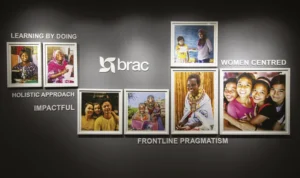
Balancing Work and Tranquility Brac International Headquarters
With changing generations, the working culture along with its surrounding environment is evolving. As employees’ lifestyles become more comfortable, there is a greater demand for modern work life and space. One such example is the newly renovated headquarters of BRAC International. The office on the 14th level of the BRAC Centre is an exception in itself. BRAC International is an international nonprofit organisation that works to empower individuals and communities affected by poverty, illiteracy, diseases, and social injustice. BRAC’s institutional expertise has successfully implemented programmes across 10 countries in Asia and Africa, impacting the lives of over 100 million people by adapting the models according to the context of the specific country. As an international nonprofit, BRAC International wanted to give a fresh look that reflected their cross-regional work as well as create a space that employees would feel proud to work in. Chinton Architects Ltd. implemented and executed the designing process, closely working with the Executive Director, Shameran Abed. The design draws heavily on BRAC’s values and their core brand DNA. The principal architects, Md Ishak Miah and Neeman Karim, along with the project architect Md Shakiful Islam Proshun and the team, designed a modern yet humble office space that draws heavily on earthy and nature-oriented office interior by using many leafy plants in the indoor office premise. There are also many beautiful photos of programme participants throughout the office to inspire the staff. “Our new contemporary office interior is one of the first of its kind in the BRAC building and several other floors have been inspired to implement similar design elements on theirs. As BRAC International staff, we feel proud of our office and enjoy working here, while welcoming our colleagues from country offices who also feel good to have such a modern and beautiful head office,” Tania Ashraf, Head of Strategy, shared with Ceramic Bangladesh. The eye-dragging view of the whole Banani and beyond is a very complimentary factor and helps the employees to release stress amidst working hours, not making them feel claustrophobic. The offices along the sides of the building are semi-frosted glass partitions with maps and skylines of major cities and countries where the organisation has a presence. The main meeting room features the Dhaka skyline. “We wanted to create a workspace where people feel inspired to come and work. We wanted our colleagues to feel proud about working with Brac International.” A few featured walls are dedicated to showcasing photos of programme participants. The four columns passing through the f loor showcase the organisation’s values – Integrity, Effectiveness, Innovation, and Inclusion. There are separate meeting rooms, which are interestingly named after the working regions. The big meeting room has clocks showing the timing of all the internationally affiliated countries. The office also has standing desks for employees to take breaks from long hours of sitting. Tania Ashraf added, “The lobby area has a collage of photographs from the f ield and reflects our DNA which is very much a part of our daily work. Every morning when we come to work, we feel inspired by seeing these images as soon we get out of the lift. We wanted to create a workspace where people feel inspired to come and work. We wanted our colleagues to feel proud about working with BRAC International. As all of us work very hard, it was important for us to create a beautiful space where we can be productive as well as remember our purpose. Authored by Rehnuma Tasnim Sheefa
Read More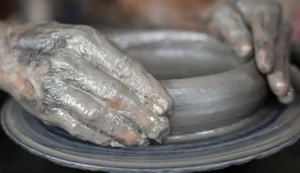
Pottery: Whether To Wither Away Or Survive? – Artisans out to retain this ancient craftwork
Which cultures do the rural Bangladesh represent since the time immemorial? Broadly, the answer might be traditional arts and crafts but what comes first is pottery, the decorative face of Bangladesh. It has a magic that master artisans have been weaving with their wand-like hands. The earthenware or clay-made wares were the essential household articles for centuries. The use of pottery was common in the celebration of various fiestas and festivals. However, is pottery a thing of the past and this fine art going into atrophy, really. Let’s look at an eye-soothing picture at Nolam Palpara, some 38 kilometres off the capital Dhaka. A handful of artisans, men and women, are absorbed in putting strenuous efforts to make pots, pitchers, jugs, glasses, bowls, buckets, small banks, pot covers, dishes, flower vases and dolls. They are out to keep their ancestral profession alive. As time passes, many in their neighbourhood have left this ancient art, yet some are still retaining pottery with profound passion. The potential of pottery is immense and this craftwork is contributing a lot to the country’s nascent ceramic sector. A potter in his late 30s, Palash Pal, told this author during a recent visit to this pottery village, said this very Nolam Palpara, in Savar upazila under Dhaka district, was once famous for the traditional artistic pottery as almost all residents were engaged in the pottery industry. Palpara people have transformed their lifestyle over the years. From the kitchenware to attire, a dramatic shift is seen as they are trying to cope with the changing trends and cultures. But a visit to some makeshift outlets near Doel Chattar adjacent to the Bangla Academy and Dhaka University campus, which stretches all the way to the High Court gate, tells us a different tale. Most of the traders expressed their utter satisfaction with pottery sales after years of stymied growth in the business. According to sector insiders, pottery business is evolving faster these days as enthusiasts from all walks of life prefer a glittery album of aesthetic pottery and terracotta showpieces. From utensils to showpieces, once upon a time their ancestors crafted and used traditional pottery items in their everyday household work. For ages, villagers used earthenware as household tools. With the passage of time, this long-held tradition has shifted drastically. Some craftspeople are exerting their efforts to boom and boost their long-standing business and tradition into a different path. Citing that his ancestors were involved with this occupation for hundreds of years, Mr Pal said in 2005, when he started this trade by acquiring hands-on training from a local artisan, a total of 40 families were engaged in making earthenware. The number has tragically come down to only eight now. Their profession remains on the line for shortage of soil, wood and funds. The oldest art of the country is clay-made crafting, that is pottery. The main raw material of pottery is soil. However, this cannot be crafted with any soil. Clean sticky soil is the key component for this clay art. Business only grows substantially during festivals. Potters struggle to survive with their craft in the rest of the year, said Mr Pal. Those who can prepare items with aesthetic value are doing better business as the demand for such items has dropped. Nobody in his village is making any aesthetic articles due to fund shortages and patronage. A good number of people throng Dhaka’s different sales points, including Doel Chattar, to buy various types of pots and pans, flower tubs, vases, showpieces, lamps, umbrella stands, portraits, toys and wall tiles, Mr Pal acknowledged. Prominent potters from Patuakhali, Dhaka, Narsingdi, Manikganj and some northern districts supply such products across the country, including the metropolis Dhaka. The 69-year-old bearded Abul Kashem Sikder, who has set up a makeshift outlet at Doel Chattar, said this place has become the biggest pottery market. He bought most of the artistic pottery products which are crafted in different parts of the country including Barishal, Cumilla, Faridpur and Dhaka’s surrounding Dhamrai, Savar and Nabinagar areas. Mr Sikder sells more than 150 items which are molded and sculpted by the local Pal community. He does not sell any traditional pottery as they are almost on the verge of extinction, he mentioned. Some foreign tourists often visit his shop and they also cannot resist the temptation of buying articles from a dazzling collection of items. Mr Sikder sells Tk 3,000-5,000 daily and his annual turnover is estimated at Tk 2.0-2.5 million. Dhaka has been the nerve centre of Bangladeshi pottery since time immemorial. The pottery industry has been settled for hundreds of years along the banks of the Banshi, including Kaggiyapara, Palpara of Dhamrai, Nabinagar of Savar, Nalam and Bhagalpur. But this art still survives with bars and barriers. For survival, many people have left their ancient calling. Even if some are trying to hold on, they too are plagued by so many pains, according to the industry people. In 1975, more or less 65 potters in the village were involved in this craftsmanship, but the number has come down to only eight now, indicating the state of the aesthetic art, he said. To mould earthenware, potters have to acquire clay through a strenuous process. They have to collect clay mainly during dry season. Initially, clay was passed through various stages of molding media like wood, stone, shell and metal before reaching the age of ceramic and porcelaina. The sexagenarian Madhob Pal, an artist and sculptor, who has three sons employed at different private organisations, was born and brought up at the same village and started crafting various sorts of pottery items 32 years back in 1990. About soil collection, Mr Madhob said potters have to acquire soil by making 8-10-foot deep holes underground by hand. Due to soil, energy and financial crises, the craft lovers will not be able to find the craft available for long, he warned. Their lifestyle has changed over time with aluminium and plastic products replacing earthenware
Read More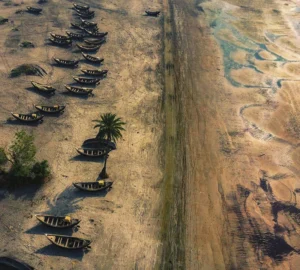
Kuakata: Sea Waves In The South
Something about the white noise of waves, the deep whirl of wind, and the melting, golden hues during the strike of twilight draws people to the affection of the sea. And among a variety of sea beaches that Bangladesh is blessed with, the unique and mesmeric Kuakata wins the hearts of all passionate travelers. Kuakata Sea Beach, the second largest one in the country, is well-known for its picturesque scenery, serene blue skies, and tidal waves. Not many people know that Kuakata has a unique trait that makes it one of a kind; it’s the only sea beach in South Asia that offers travelers a full view of sunrise and sunset. People gather here to relish the therapeutic hours of the sun rising and later disappearing at dusk, reflecting golden highlights in the water of the Bay of Bengal. Origin of the name The name “Kuakata” is derived from the words “Kua,” which means “a well in earth for drinking water,” and “Kata,” which means “the digging of earth.” It’s taken from the legendary well dug on the seashore by early Rakhine settlers in their quest for drinking water after being expelled from Myanmar by the Mughals in 1784. Now home to Hindu and Buddhist communities, the neighbouring “Rakhine Palli” is comprised of a small ethnic group. Spending a few hours exploring there, one can learn about different aspects of the diverse lifestyle of the Rakhine villages; observe the handloom skills of the villagers; and come across handicraft shops at the well-known Rakhine Market. The Buddhist temple and the legendary well are located to its south. It is known that the beauty of the temple was influenced by Chinese architecture. The temple has a statue of Buddha about 30 feet high, claimed to be the highest in Bangladesh. Opening of Padma Bridge & New Opportunities Located 320 kilometres away from Dhaka, the beach is situated in the Lotachapli Union, Kalapara Upazila, Patuakhali administrative district under Barishal division. Earlier, it would take 9-10 hours to travel to all southern destinations by road or river. The bridge over mighty Padma has whittled down the distance between Dhaka and Kuakata to nearly 300 kilometres. The trip takes about six hours, which is almost half the time it used to take earlier. During the time of Eid-ul-Azha in mid-July, every hotel and motel was fully booked and was overcrowded with tourists who traveled long distances to see the magnificent sunrise and sunset at Kuakata. However, the Sundarbans and Kuakata-oriented tourism had faced a decline in the past few years. When asked about this, local businessmen and hotel owners said business has been booming nowadays. They are optimistic about reversing the trend since the global pandemic. They said since Kuakata has become more accessible, thanks to easier conveyance and infrastructural development, the number of tourists would increase in the coming days. Places to Travel Around There are a few nearby tourist attractions with diverse biodiversity. A series of coconut trees and an evergreen thicket of ‘Jhau Bon (forest)’ add to the beauty of the beach. The woodland is within walking distance from the seashore and is an excellent spot for watching the sunrise. There is an eco-park, a fascinating place for a picnic or perfect retreat. The Gangamati Reserved Forest is located to the east of the Jhau Forest. To the east of Kuakata beach, beyond the Gangamati forest, there is a crab island full of red crabs. It is said that the red crabs flock to the beach to look for solitude. Local kids around the beach get thrilled to catch the red crabs and bring them over to the tourists. During the travel season from October to March, speed boats are offered from Kuakata beach to Crab Island. Festivities add more vibrancy to a place. Thousands of devotees gather here during the festivals of “Rush Purnima” and “Maghi Purnima.” On these occasions, they perform holy baths and enact traditional fairs. These festive events make the Kuakata beach more appealing to visitors, adding life to the serene views of the lush forest and colourful sailing boats in the Bay of Bengal. Another beautiful forest, known as Fatra Forest, is found at the extreme east of the Sundarbans forest range as soon as the river is crossed, on the west side of Kuakata beach by an engine boat. Even though this forest contains a majority of the Sundarbans, no wild animals are present. In this forest, one can witness numerous birds, monkeys, and wild hens. In the winter, migratory birds are found around the spot, which is another spectacular feature of Kuakata. There are arrangements to visit these protected forests, including Fatra, Laldia, Harinbaria, and Sonakata Ecopark, which are adjacent to the Sundarbans by boat. Many deer are spotted around the forests, and they are seen as comfortable around tourists. With three to four hours in hand, one can tour these amazing places. An interesting place here is Shutki Palli, or “Dry Fish Village,” located at the western end of Kuakata beach. From November to March, the dry season lasts. The fish gets salt-cured and sun-dried on the beach after being caught in the sea. You can spend time watching the busy schedule and lifestyle of these fishermen and get to buy a variety of dried fish at reasonable prices. Where to Stay For accommodation, many hotels are available nearby, from which one can choose according to comfort, convenience, and cost. Some notable ones are Kuakata Grand Hotel, Hotel Graver Inn, Kuakata Inn, Hotel Nilanjona, Hotel Sea View, Hotel Sea Queen, Parjatan Motel Youth Inn, Beach Haven, and Sikder Resort and Villa. In the case of food, the hotels prepare the meals for the guests in their restaurants. Besides, a variety of local cuisine is also available in local restaurants around. The Best Time to be here The best time to visit Kuakata is when you can fully immerse yourself in the experience without having to worry about the inconveniences. The best month is
Read More
